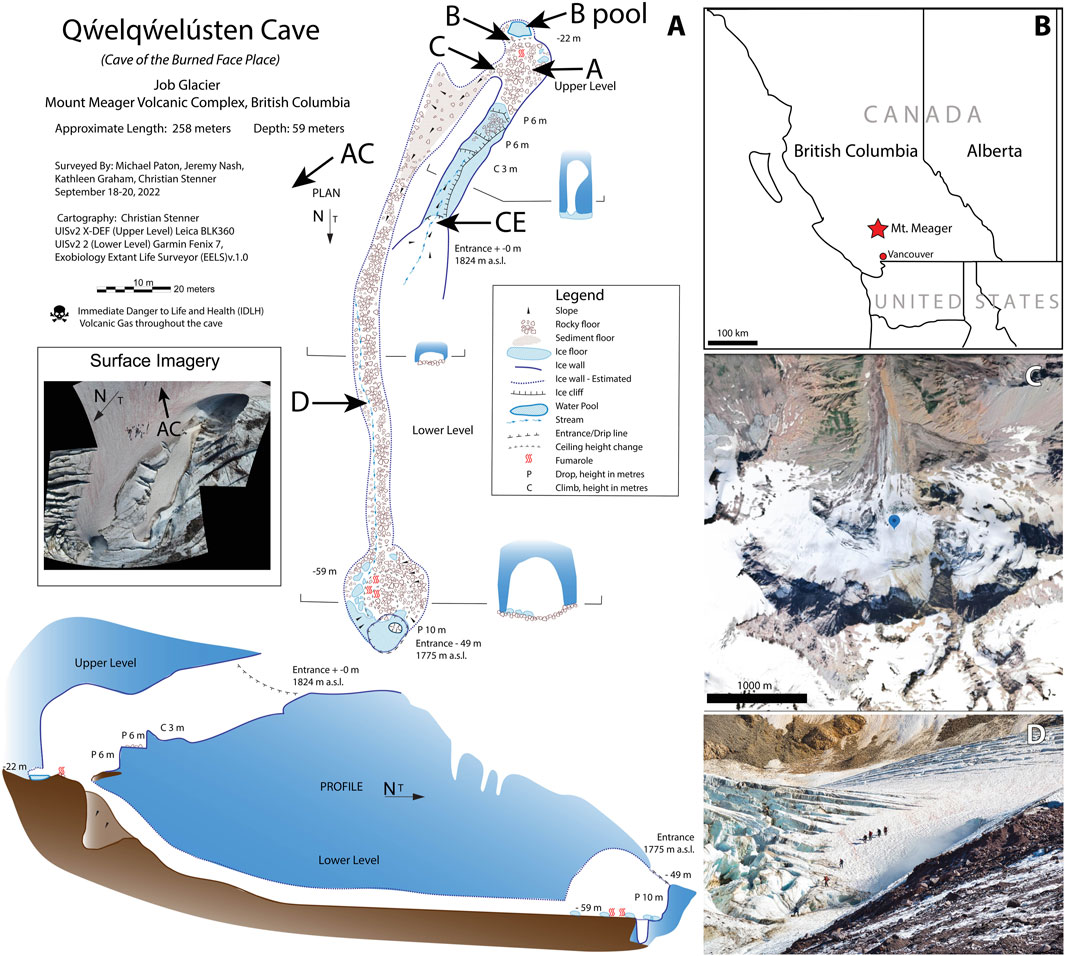Cave Deposits Reveal a Permafrost-Free Arctic – eos.org

Report on Arctic Permafrost Thaw and its Implications for Sustainable Development Goals
Executive Summary
A recent paleoclimatological study reveals that the Arctic was largely free of permafrost approximately 8.7 million years ago, a period when global average temperatures were 4.5°C higher than present day. Analysis of Siberian cave deposits provides a critical historical analogue for potential future climate scenarios. The findings underscore the profound sensitivity of Arctic permafrost to global warming and highlight the severe risks posed to the achievement of multiple Sustainable Development Goals (SDGs), most notably SDG 13 (Climate Action). The potential for massive carbon release from thawing permafrost constitutes a significant positive feedback loop that could accelerate climate change, jeopardizing global efforts to maintain a stable climate.
Research Background and Methodology
The Permafrost Carbon Reservoir: A Challenge to SDG 13
Perennially frozen ground, or permafrost, covers approximately 15% of the Northern Hemisphere’s land area. This frozen soil is a critical component of the global climate system and a key concern for SDG 13 (Climate Action) and SDG 15 (Life on Land).
- The Arctic permafrost region currently stores an estimated twice the amount of carbon as is present in the entire Earth’s atmosphere.
- As the Arctic warms at a rate approximately four times the global average, this vast carbon reservoir is becoming increasingly vulnerable to thawing.
- The decomposition of previously frozen organic matter releases potent greenhouse gases, such as carbon dioxide (CO₂) and methane, into the atmosphere, creating a feedback mechanism that exacerbates global warming.
Methodological Approach: Terrestrial Climate Archives
The study utilized speleothems (mineral cave deposits such as stalagmites) from northern Siberia as a novel terrestrial climate archive. This research represents a significant international collaboration, aligning with the principles of SDG 17 (Partnerships for the Goals).
- Speleothems can only form when liquid water percolates through the ground, meaning their presence in a currently frozen region is definitive evidence of a past, thawed state.
- Using uranium-lead dating techniques, researchers determined the speleothems formed 8.7 million years ago during the late Miocene period.
- Isotopic analysis of the cave deposits allowed for the reconstruction of local temperature conditions, providing a precise environmental snapshot from a warmer geological epoch.
Key Findings and Relevance to Global Goals
A Historical Analogue for a Warmer World
The study’s primary finding is that extensive permafrost was absent from the Siberian Arctic during the late Miocene. This historical evidence provides a stark warning regarding the potential consequences of failing to meet the targets of SDG 13.
- During the period of speleothem formation, local average temperatures in the region were 19°C–23°C warmer than today.
- This localized warming corresponds to a global average temperature that was 4.5°C higher than the present, illustrating the phenomenon of Arctic amplification.
- This research provides crucial terrestrial data that complements existing marine sediment records, strengthening climate models used to forecast future changes.
Analysis of Permafrost Instability on Sustainable Development
Direct Threat to SDG 13: Climate Action
The potential for widespread permafrost thaw represents a critical tipping point that could severely undermine global climate mitigation efforts. The Intergovernmental Panel on Climate Change (IPCC) estimates that for every 1°C of global warming, thawing permafrost could release 14–175 billion tons of CO₂.
- The study authors calculate that a complete loss of Arctic permafrost, even accounting for only the top three meters of soil, could release 130 billion tons of CO₂ in the short term.
- Such a massive release would drastically accelerate global warming, making the goals of the Paris Agreement and SDG 13 significantly harder, if not impossible, to achieve.
- This process is already underway, with observations of permafrost thaw in areas of the Arctic due to recent temperature anomalies.
Cascading Impacts on Other Sustainable Development Goals
The consequences of permafrost degradation extend beyond climate feedback loops, impacting a range of interconnected SDGs.
- SDG 15 (Life on Land): Thawing ground destabilizes Arctic ecosystems, altering hydrology, threatening endemic species, and impacting vegetation cover.
- SDG 11 (Sustainable Cities and Communities): Infrastructure in Arctic regions, including buildings, roads, and pipelines, is built on permafrost. Thawing leads to subsidence, causing billions of dollars in damage and threatening the safety and viability of northern communities.
- SDG 7 (Affordable and Clean Energy): The report’s findings amplify the urgency of transitioning to clean energy sources to limit warming and prevent the activation of such dangerous climate feedback mechanisms.
- SDG 14 (Life Below Water): Arctic amplification is inextricably linked to the loss of sea ice and changes in ocean heat transport, which have profound effects on marine biodiversity and global ocean circulation patterns.
Analysis of Sustainable Development Goals in the Article
1. Which SDGs are addressed or connected to the issues highlighted in the article?
- SDG 13: Climate Action
- SDG 15: Life on Land
- SDG 14: Life Below Water
- SDG 17: Partnerships for the Goals
2. What specific targets under those SDGs can be identified based on the article’s content?
-
SDG 13: Climate Action
- Target 13.2: Integrate climate change measures into national policies, strategies and planning. The article underscores the urgency of this target by highlighting the massive carbon reservoir in permafrost (“twice as much carbon as the entire atmosphere”) and the potential for a dangerous feedback loop where “thawing comes with huge repercussions because it feeds back into future warming.” The frightening calculation that a complete loss of permafrost could release 130 billion tons of CO2 emphasizes the need for immediate policy action to mitigate global warming.
- Target 13.3: Improve education, awareness-raising and human and institutional capacity on climate change mitigation, adaptation, impact reduction and early warning. The scientific study itself is a primary example of this target in action. By researching and publishing findings on the historical state of Arctic permafrost and the potential consequences of its thaw, the scientists are raising awareness and providing crucial data for understanding climate change impacts. The article’s purpose is to disseminate this knowledge to a wider audience.
-
SDG 15: Life on Land
- Target 15.1: By 2020, ensure the conservation, restoration and sustainable use of terrestrial and inland freshwater ecosystems and their services, in particular forests, wetlands, mountains and drylands, in line with obligations under international agreements. The article directly addresses the threat to a major terrestrial ecosystem. It states that “About 15% of the land area in the Northern Hemisphere is currently covered by perennially frozen soil known as permafrost.” The entire study revolves around the thawing and degradation of this ecosystem due to climate change.
- Target 15.3: By 2030, combat desertification, restore degraded land and soil, including land affected by desertification, drought and floods, and strive to achieve a land degradation-neutral world. The thawing of permafrost is a form of land degradation. As the “perennially frozen soil” thaws, it fundamentally alters the landscape and the soil structure, releasing vast amounts of carbon and impacting the stability of the ground. The article’s focus on the “complete loss of permafrost” is a discussion of large-scale land degradation.
-
SDG 14: Life Below Water
- Target 14.2: By 2020, sustainably manage and protect marine and coastal ecosystems to avoid significant adverse impacts, including by strengthening their resilience, and take action for their restoration in order to achieve healthy and productive oceans. The article connects the thawing of terrestrial permafrost to marine factors, noting that Arctic amplification is likely due to a “complex interplay of various factors, including loss of sea ice… and ocean heat transport.” This shows how the health of marine ecosystems (sea ice) directly impacts climate phenomena that threaten terrestrial ecosystems.
-
SDG 17: Partnerships for the Goals
- Target 17.6: Enhance North-South, South-South and triangular regional and international cooperation on and access to science, technology and innovation. The research described in the article is a clear example of this target. The text mentions that the study was conducted by an “international group of colleagues” and was “decades in the making,” highlighting a long-term, collaborative international scientific effort to understand a global climate issue.
3. Are there any indicators mentioned or implied in the article that can be used to measure progress towards the identified targets?
-
Indicators for SDG 13 (Climate Action)
- Greenhouse Gas (GHG) Emissions: The article is centered on CO2. It provides specific quantities that serve as indicators of the problem’s scale, such as “14–175 billion tons of CO2 could be released… for every 1°C of global warming” and a potential release of “130 billion tons of CO2” from the top 3 meters of soil. Measuring actual emissions from thawing permafrost would be a direct indicator of progress (or lack thereof).
- Increase in Global Average Temperature: The article uses global temperature as a key variable, noting that the Arctic was permafrost-free when the “average global temperature was 4.5°C (8.1°F) higher.” It also mentions that a 4.5°C warming scenario is at the “extreme end of climate models.” Tracking the global average temperature is a primary indicator for climate action.
- Rate of Regional Warming: The article specifies that “the Arctic is warming at about 4 times the global average.” This phenomenon, “Arctic amplification,” is a critical indicator for assessing climate-related hazards in a specific, vulnerable region.
-
Indicators for SDG 15 (Life on Land)
- Proportion of Land Degraded: The article provides a baseline: “About 15% of the land area in the Northern Hemisphere is currently covered by… permafrost.” An indicator of land degradation would be the measurement of the area or volume of permafrost that thaws over time. The article mentions that “the upper layers of permafrost were thawing in multiple areas in Svalbard,” which is a qualitative observation of this indicator.
-
Indicators for SDG 14 (Life Below Water)
- Sea Ice Extent: The article explicitly identifies the “loss of sea ice” as a contributing factor to Arctic amplification. Therefore, measuring the extent of Arctic sea ice is an implied indicator relevant to the interconnected issues discussed.
-
Indicators for SDG 17 (Partnerships for the Goals)
- International Scientific Collaborations: While not a quantitative metric, the article’s description of the research team as an “international group of colleagues” who worked for decades serves as a qualitative indicator of successful scientific partnership in line with Target 17.6.
4. Table of SDGs, Targets, and Indicators
| SDGs | Targets | Indicators |
|---|---|---|
| SDG 13: Climate Action |
13.2: Integrate climate change measures into national policies, strategies and planning.
13.3: Improve education, awareness-raising and human and institutional capacity on climate change mitigation. |
– Amount of CO2 released per 1°C of global warming (e.g., “14–175 billion tons”). – Total potential CO2 emissions from permafrost thaw (e.g., “130 billion tons”). – Increase in global average temperature (e.g., “4.5°C higher”). – Rate of Arctic warming relative to the global average (e.g., “4 times the global average”). |
| SDG 15: Life on Land |
15.1: Ensure the conservation and sustainable use of terrestrial ecosystems.
15.3: Combat desertification, restore degraded land and soil. |
– Proportion of land area covered by permafrost (e.g., “15% of the land area in the Northern Hemisphere”). – Measured extent/area of thawing permafrost over time. |
| SDG 14: Life Below Water | 14.2: Sustainably manage and protect marine and coastal ecosystems. | – Extent of sea ice cover (mentioned as “loss of sea ice”). |
| SDG 17: Partnerships for the Goals | 17.6: Enhance international cooperation on and access to science, technology and innovation. | – Existence of long-term international scientific research groups (e.g., “international group of colleagues”). |
Source: eos.org

What is Your Reaction?
 Like
0
Like
0
 Dislike
0
Dislike
0
 Love
0
Love
0
 Funny
0
Funny
0
 Angry
0
Angry
0
 Sad
0
Sad
0
 Wow
0
Wow
0


-1920w.png?#)





































































